Blog metrics: Website traffic is the obvious one we track (and obsess over), but HOW is it actually useful? Which digital marketing metrics should you actually CARE about and will translate into actions for GROWTH? This post is also available in podcast format on \\ iTunes \\ Stitcher \\ Google Play \\ Overcast \\ Spotify)
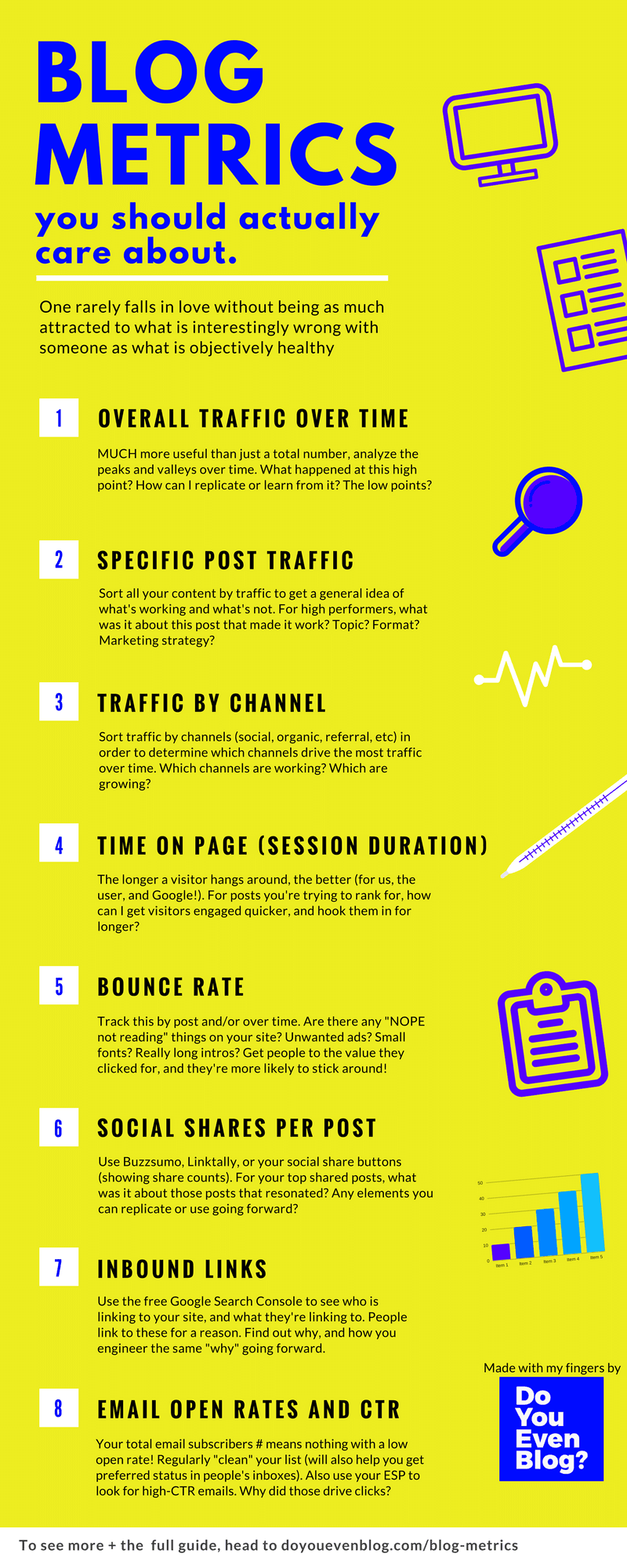
We’ve all been there…
We’ve plugged our blogs into Google Analytics, hit publish, added to social queues, then hit refresh.
*waits
Blog traffic. We live or die by it, right?
But then we get frustrated when that number doesn’t grow. When our BLOG doesn’t grow. How can we get our blogs to grow?
The answer?
By setting, tracking, and continuously optimizing for the RIGHT blog metrics.
Well have no fear. We’re going to dive into:
- WHICH metrics you should be tracking as a blogger (Yes, traffic is still one of these, but it’s NOT what you might think…), and more importantly
- HOW to translate metrics into actions that grow your blog.
But before we list them, you need to understand…
The most important metrics to monitor depends entirely on your goals.
We have to state this up front…
For some bloggers, overall site traffic might be the most important metric to track. For others, site traffic is literally useless on it’s own (but IS vital for other metrics that DO matter. More in a second on this…)
If your goal is…
- Making as much money as possible via ads and affiliate links: Traffic is hugely important, as are click-through rates and affiliate conversion rates
- monetize your blog through premium product launches: loyal, trusting, and eager “true fans” are more important, as is your email list size and open rates, as well as email opt-in conversion rates
- To change and impact as many people as possible: Shares per post is super important, as is average comments per post and individual post topic (so you know what’s resonating
- To become an influencer: As much social proof metrics as you can manufacture 😉
The point?
The list below is NOT set in stone, and depends on your goals!
The bottom line of tracking metrics is this:
- Know your goals
- Figure out which metrics are indicators of working TOWARDS your goals.
- Find what works, and what doesn’t work.
- Do more of what works.
Simple, but not easy.
Think about this: For whatever your goals are, does overall website traffic show if you’re making progress towards your goals? For some maybe, for most of us…no. It does not. So let’s find what does?
The blog metrics you should track:
NOTE: These are NOT in any particular order, as which ones you prioritize depend on your goals 🙂 🙂 🙂
- Overall Website visits (just below) and specific post visits
- Blog traffic by channel
- Time on Page (session duration)
- Bounce rate
- Social shares per post
- Average comments per post
- Average inbound links
- Email subscribers, open rate, and CTR
- Clicks from social platforms
- SERP Ranking
- The “Check Your Blog Stats” Planner and Checklist
Metric 1 – Overall website visits (i.e. blog traffic!)
Please please please read this next sentence carefully.
Site visits by itself is a near-useless metric. SO STOP F&$*ING WORRYING ABOUT IT EVERY MONTH.
Sorry. Was talking to myself.
However, in conjunction with other information, visits and sessions can be incredibly useful for bloggers!
First, specific post visits is an amazing way to discover what resonates.
Remember the 4-step formula above? Where our goal is to find what works for progressing towards our goals…and what doesn’t?
Well, this is that.
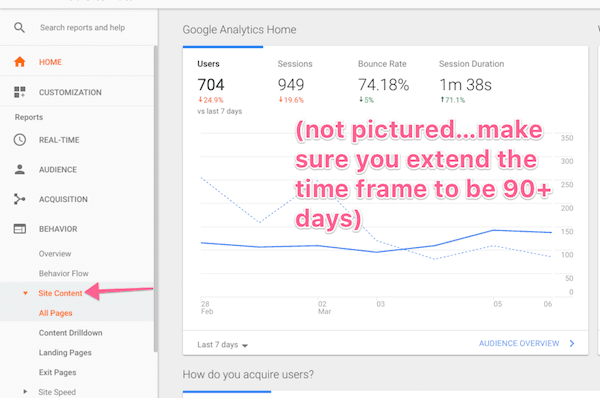
Here’s what you’d do:
- Head to Google Analytics, and click on Behavior – Site Content – All Pages
- Extend the time frame!
That last part is important, ALL of your blog posts will get high traffic the first few days after you publish…so in your effort to find your best-performing content, make sure the Analytics time-frame is 90+ days.

- Now you have a list of your top performing pieces of content by traffic
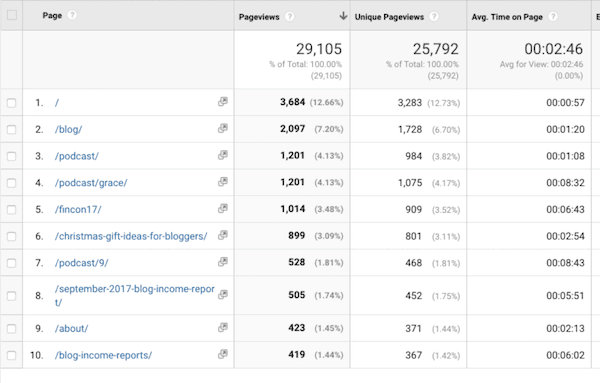
Your homepage will always be up top, and post traffic isn’t a super standalone metric by itself either, but it’s WAY more useful than overall site visits!
FAQ: What can you use this information for? Try turning your top post into an evergreen content upgrade via ebook, checklist, course, webinar, etc. It’s clearly something your audience cares about, and can be used as a lead-magnet going forward!
Second, overall site traffic growth over time gives you insights
Screw the actual traffic number, use the graph!
Regardless of the visits/sessions NUMBERS, the roller-coaster looking graph shows us FAR more useful blog metrics.
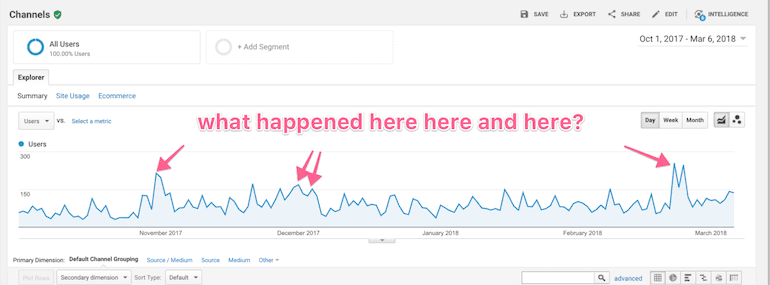
- Look at the mountains – what did you DO during these periods of high traffic? Specific posts that worked well? New marketing strategies that worked well?
- Look at the dips – What happened here? Long breaks in publishing? Trying out a new platform? Did you focus on a specific topic your audience doesn’t care about?
Remember, we’re trying to figure out what worked so we can do MORE of that, and what didn’t work so we can do LESS of that.
That’s the super magic secret of blog growth.
Metric 2 – Blog traffic by CHANNEL (traffic source breakdown)
Why’s it awesome? It allows you to figure out which social channel is “your one channel,” as well as optimize your reins on Pinterest.
This one’s huge:
In your Google Analytics dashboard, head to Acquisition – All Traffic – Channels.
Here you’re presented with your different “channels,” which basically just means “where people are clicking through to your site.”
They’re also referred to as mediums:
- Social = Twitter, Facebook, Pinterest, etc
- Organic = found via Google, search engines, etc
- Direct = It’s SUPPOSED to be when somebody directly types in your URL or uses a bookmark in their browser…but it’s also a “default” category that Google Analytics uses when it’s NOT SURE where your traffic came from.
- Referral = Usually traffic from other people’s websites, backlinks, etc!
- Email = traffic from urls marked with the medium UTM (Please just ignore this one)
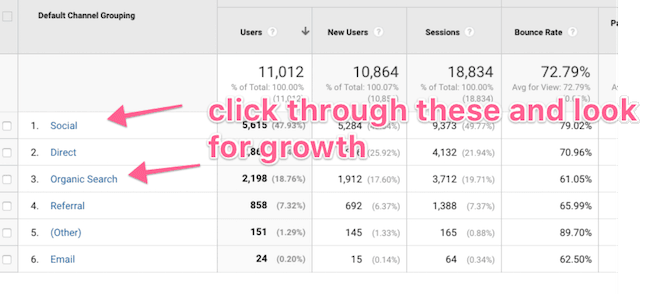
Aside from seeing which other social channels are performing well for you (which is handy, but also pretty obvious), you can click through to each one and look at which ones are GROWING.
This should tell you where to focus most of your marketing, especially on channels where followers don’t play a big a role (I.e. Pinterest and Google).
This is especially useful for Pinterest
For example:
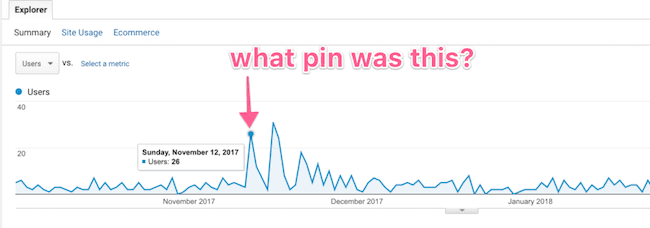
There’s my Pinterest traffic from a few months back (needless to say I haven’t mastered this channel yet).
But look at those peaks. What post was that??
By taking note of those DATES, and digging into Acquisition – Social – Landing page in my dashboard, I was able to see which blog post did so well on Pinterest those days:

AND given the way Pinterest works, I can further dig in to MORE blog metrics and identify which pins precisely did the best…then I can re-pin those!
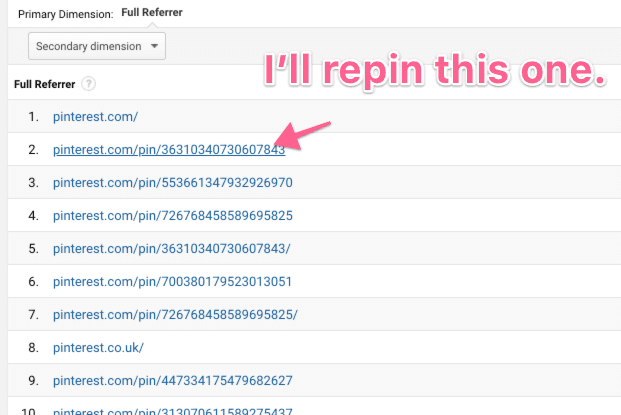
This one of the best blog metrics to monitor ever few weeks, for Pinterest traffic specifically.
Metric 3 – Time spent on page (session duration)
This particular stat can be found all over the place in Google Analytics, and is only useful for ONE THING:
SEO.
As we’ve already discussed in this SEO discussion with Grant, Google Rankbrain cares deeply about how people engage with our content.
The amount of time people spend on any given page is a basic indicator of “how useful they’re finding that piece of content.” At least per Google’s eyes.
Here’s the best place to check session durations:
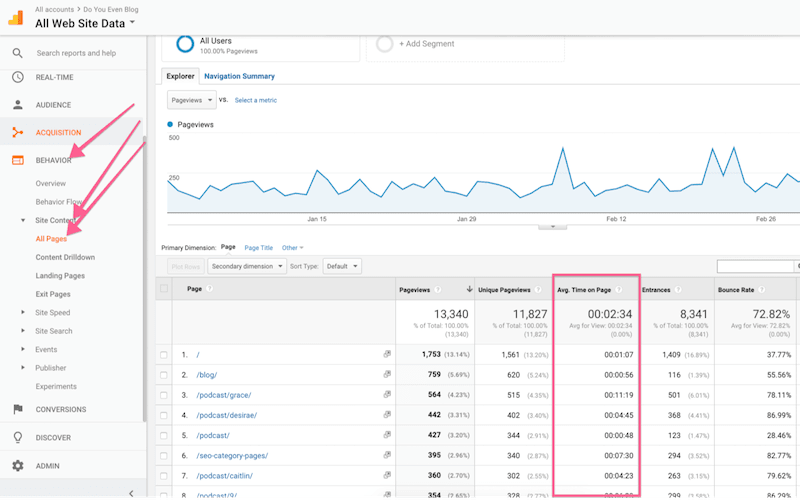
WP Dashboard – Behavior – Site Content – All Pages
There’s you’ll be able to check out how much time visitor are spending, on average, for each blog post (make sure to stretch out the time frame in the top right.)
Session duration can and should be used alongside other stats, ie:
- Social channel = which social channels end up with the highest time on page? These will likely end up converting into email subscribers better.
- SERP Ranking (see below) = For your blog posts ranking on pages 2, 3, or 4…how can you increase session duration to help it get to page 1?
TIP: Don’t bother checking session duration on it’s own. It’s only really a high-ROI activity when used in conjunction with checking SERP or social channel engagement.
Check once a month or so, or just when needed.
Metric 4 – Bounce rate (how much do we care about this?)
This goes back to the whole engagement and UX (user experience) thing.
3 people care about this:
- Google – See above on session duration.
- Your readers – The experience a user has on your site is HUUUUGGGGGEEEEE. Hugely important.
- You – You care about readers, per #2 above, so…
Seriously, user experience is pretty much everything, isn’t it?
It could be the difference between an email subscriber, or not. A sale, or not. An affiliate referral, or not.
And bounce rate is a decent indicator of user experience (as well as relevancy…i.e. was the content related to the marketing/copy that drove the click?)
FAQ: Bounce rate = the percentage of visits (sessions in Google Analytics) where people see only ONE page before leaving your site.
Have you ever landed on a site and got this?

And the New York Times wonder why more and more people are getting their news from places like Twitter and Medium. Goodness.
Here are a few UX things you can do to cut down on bounce rate:
- Nail down typography – Please bump up your font size! Especially on desktop. No less than 15px, preferably 16-18px for paragraphs, depending on your font.
- No “walls of text” – Nobody reads those paragraphs people. Limit your paragraphs to cover no more than 5-6 lines on the page. Usually 2-5 sentences.
- Limit ads, etc above the fold – The general rule is to get people INTO YOUR CONTENT as quickly as possible.
- Have a tantalizing intro – Read this short article on Copyblogger to learn how, but your intros must absolutely suck people in to the rest of your content
For further reading on improving UX and decreasing bounce rate, check out this post on BuildFire.
Metric 4 – Social shares per post
This is one my FAVE blog metrics, and I might even recommend it as THE metric to care about the most.
Here’s why:
It’s one of the only metrics that applies to everybody’s goals, AND is an awesome indicator of…
- What types of content performs best
- Where that content performs best.
There are a number of ways to calculate this:
- Use Buzzsumo, or LinkTally (this is super cool. Just discovered it this morning. Built by Hubspot)
- Use your social media sharing button plugin (Sumo is what I use, but also Social Warfare, Simple Share Buttons, etc).
- Your social media tool (Buffer, Hootsuite, I use SmarterQueue)
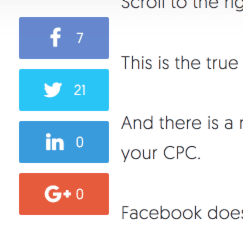
TIP: Look for the outliers. Don’t bother with anything that performs “normal” on any of your social platforms. Just DON’T MISS the posts that stand out and being shared a ton more than usual.
This is something I’m consistently monitoring for Do You Even Blog. I’m searching for…
- Which topics YOU care about
- Which posts I could turn into Facebook ads (highly shared posts tend to perform better on FB ads)
- Where my audience is hanging out. Hint: It’s not LinkedIn 😉
Now back to engagement…
Metric 5 – Average comments per post
Both Jillian from Montana Money Adventures and Tanja from Our Next Life were HUGE on blog comments (actually just engagement in general, which they both place a premium on). (I also had them on the podcast here and here, respectively)
The reason?
If your ultimate goals revolve on blog income, reach, and impact (which yours SHOULD, else why the heck are you on this site?)…well..
Engagement is the key that unlocks the door to blog revenues and social impact.
Ain’t nobody nowhere going to buy from people they don’t know, trust, respect, etc. Engagement is the metric tends to track that.
Bad news though:
These are NOT easy blog metrics to just click a button and track (though I’m considering building an app for this).
Some marketing metrics platforms (like Kissmetrics, etc), might show this as a simple number…but for the rest of us humans, we’ll have to check-in manually in our platform (i.e. WordPress).

You could take your total comments and simply divide by your total number of posts for a rough estimate, or you could do what I do:
Simply scroll through your blog posts dashboard and looking for two things:
- Outliers – these pieces of content tend to engage well (or I just ASKED for comments?), and indicate which topics I can write about to increase general engagement and trust in my brand
- Duds – There will definitely be several posts that have NO comments. I try to sense if there’s a trend with these (a creation format or topic?), etc.
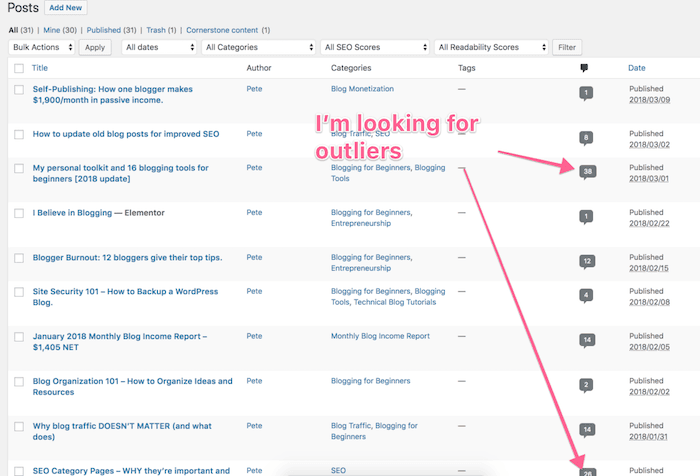
Overall, blog engagement is a tricky thing to track, as it involves examining many parts. However, blog comments is one large part of that.
(Another is social shares, and another is email engagement….but more on that in a second).
Metric 6 – Average inbound links
Note: You should NOT be looking at this stuff every day, or even every week.
It’s simply not worth your time.
However, tracking backlinks is a legit part of any SEO strategy, AND it serves another huge purpose: it’s a great indicator of content quality.
People don’t link to your content for no reason, they link to it because they found it useful, interesting, etc.
Here’s how to track inbound links:
For free, using Google Search console
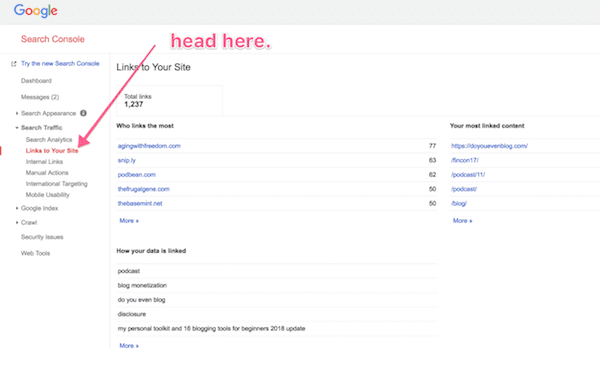
This is probably more than enough for 99% of bloggers. You can also click “more >>” and see the full list.
For example, my FinCon takeaway post has a crazy amount of backlinks and referring domains…which might give me insights like…
- bloggers like being mentioned (I mentioned several in the post).
- lots of other blogger wrote round-up posts about conference experiences.
- people love reading about shared experiences, especially in-person
- etc
(Also, for more advanced backlink analysis and link-building work, you’ll want to grab KWFinder at $30month. That suite of SEO tools also comes with LINKMiner!/
Related metric – Pages per visit
Internal links count too!
For both SEO, display ads, and user experience 🙂
If you’re not already, you should be linking to your best pieces of content…from your other pieces of content.
This shows Google (and your users) which pieces of content are your best. And you should make it as easy as possible for readers to quickly and easily discover MORE amazing content on your site.
The more clicks there are, the more pages people visit, the longer they stay on your site…the better chance you have at converting them into “true fans.”
Metrics 7-9 – Email subscribers, open-rates, and click-through rates
In a recent interview on Nick Loper’s podcast, I heard…
‘How big is your email list?’ Is the internet marketing equivalent of ‘hey bro how much do you bench???’
It’s true, isn’t it?
We’re preached to constantly on the HUGE importance of building an email list…and rightfully so…but it also leads many bloggers to focus on a metric that doesn’t really mean ANYTHING.
Email list size.
TIP: Email list growth is important, but only if you can maintain OPEN and click-through rates!
Total email list size – Why it doesn’t matter.
Consider the following two scenarios:
- Your list size is 1,000, with 10% open rate (on average)
- Your list size is 300, with 33% open rate (on average)
Either way, your getting roughly 100 people opening your emails, so total list size by itself is useless.
In fact, scenario 1 above is going to be seen by inboxes everywhere as a LOT less favorable.
This means…
Email open rates – Why it’s huge.
If your ultimate goal in email marketing is to drive traffic and sales, you should care about people actually GETTING and OPENING your emails.
The “opening” part should explain itself, but the “getting” part is worth talking about.

Email Services Providers (Mailchimp, ConvertKit, etc), as well as inboxes (Gmail, Outlook) will give generally give preference to email newsletter with high open and click-through rates.
(FYI, the underlying reason is that low-open-rate lists tend to receive more spam complaints, hitting the spam box more, etc…AND new subscribers clicking links in your newsletter signifies their continued interest in receiving the emails)
TIP: Regularly clean your email list by removing “cold” subscribers who haven’t open any emails in 30-90 days. This will help reduce your emails going to spam folders, promotion inboxes, etc.
Email click-through rates – we love clicks!
As bloggers, ain’t nothing better than clicks.
While I prefer to see email marketing as ALSO brand-building and creating an open line of engagement…it’s also just a great way to drive traffic to your blog.
So, diving through your old emails and checking CTR (click-through rates) could help show you:
- Which emails work best – For high CTRs, was this a short email? Long? How many total links in the email? Was the link clearly marked? Etc
- Which topics your audience cares about – Hmm this topic gave 3 clicks, while a similar email with a different topic got 55 clicks. Hmm.
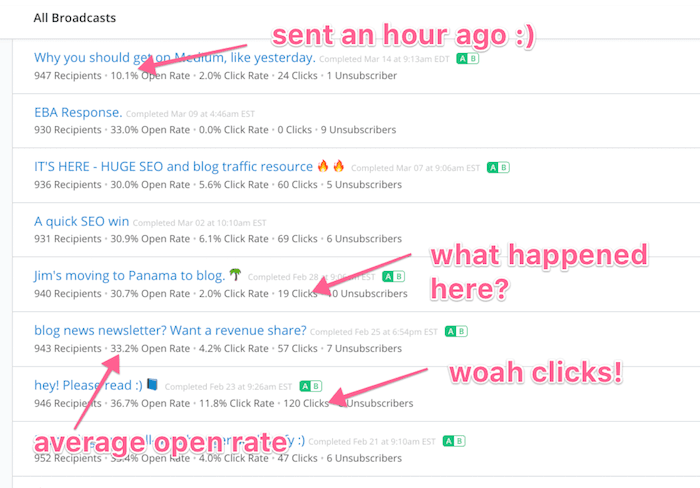
While I’m pretty happy with a 33% open rate, I haven’t cleaned my list in several months now. Once I do it again it’ll likely pop up to 50% for a while.
Metric 10 – Clicks from social platforms (for marketing, not content)
This blog metric is a bit different, as we’re not specifically trying to figure out which pieces of content perform best…but rather which pieces of marketing.
Namely,
- Copywriting
- Images
The “social shares per post” metric above is a better indicator for determining hot content…but it’s equally important to nail down which ASPECTS of your posts, tweets, pins, etc…work.
And which don’t.
The best place to find this data is in your social media platform.
In Buffer, you can see (a puny amount of) analytics…including the ability to sort by click:
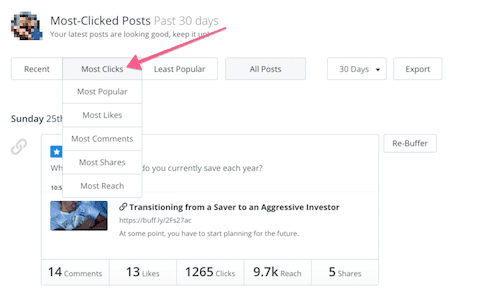
In SmarterQueue, you can see (an insane amount of) analytics.
/(Yes, I’m a complete SmarterQueue fanboy. You can also use my affiliate link here to get a double-length free trial!)
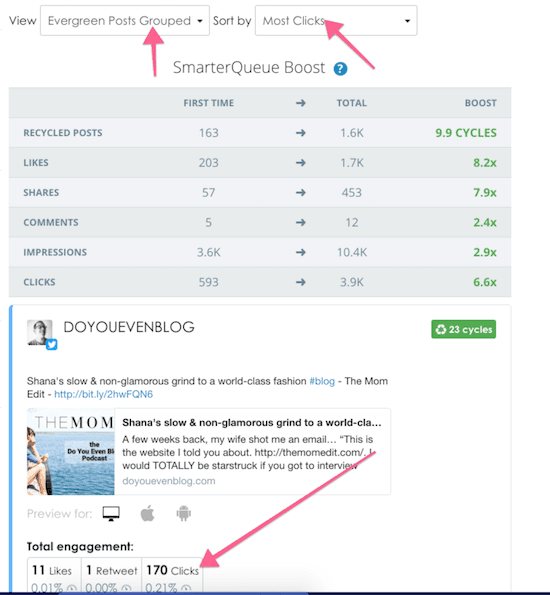
Once you’ve found which posts drove the most clicks, you can ask yourself some of the following:
What was it about THIS post?
- The copywriting? Long? Short?
- Tagged other people? Used hashtags?
- Image had a certain color or featured a sexy image of Brad Pitt?
- A certain time of day?
- A new piece of content, or old one?
What can I takeaway and use for future marketing?
As we’re trying to drive traffic, this blog metric helps us figure out what the heck we’re doing on our marketing channels.
Remember, the goal is to find what works, and do more of that.
Metric 11 – SERP Ranking
While you can’t really calculate this, it’s still an excellent indicator of how well your content is performing.
FAQ: SERP = Search Engine Results Page. It’s where you find out how your content ranks in Google.
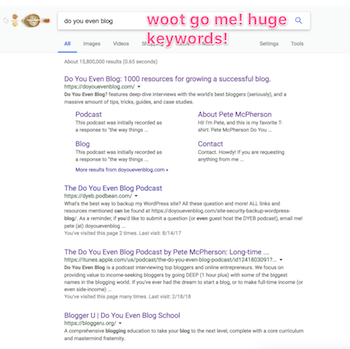
Tracking different parts of your SERP is useful for two reasons:
- You can monitor specific pieces of content for POO (page one opportunities)
- A general indicator of what you can rank for going forward.
#2 is boring, but we need to talk about POO for a second:
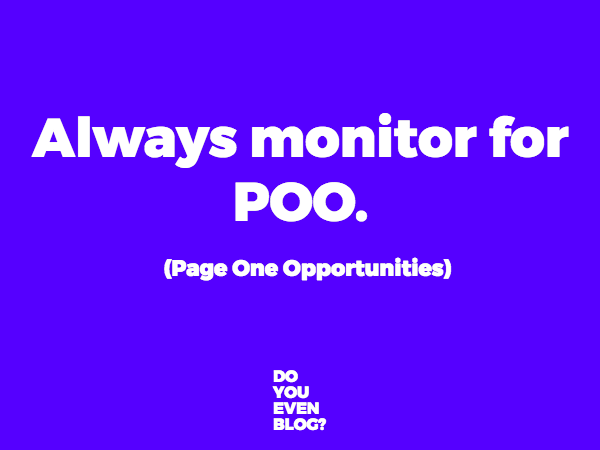
When you publish a piece of content that ends up on page 2, 3, or even 4 of search results…this is a huge POO.
These posts are HUGE opportunities to go back and edit a bit…with the hopes of driving it up to page 1!
To learn how to do this, head to: How to update old blog posts for improved SEO.
How to track your SERP (for POOs and other stuff)
I can’t stop saying POO.
There are two ways you can track SERP as part of your blog metrics routine:
- Use software
- Track manually.
Ask far as software goes…
ALL of these companies have amazing products. I’ve used SEMrush before, and it’s killer.
However, you can probably guess which one I actually pay for 😉
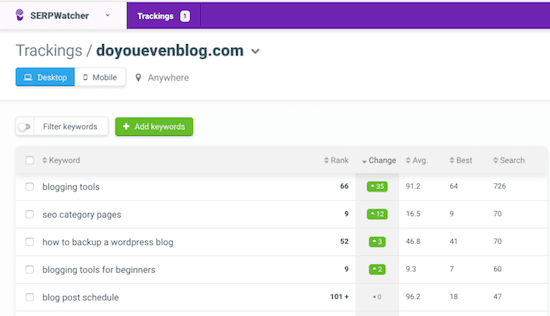
Want to track SERP manually?
You’re in luck!
I’ve created a free Google Sheets template for you, available below. Here’s what you’ll do:
- Whenever you publish a piece of content, write down the name and the keywords you’re targeting.
- Leave it alone for a few weeks.
- Periodically check back in, do a quick Google search for the keywords, and check to see where you’re at….
- If you’re NOT on the first 3-4 pages….don’t go searching further. Just put down “N/A” in the rank column 🙂
That’s it.
Click here to grab the free manually SERP tracker template. No opt-in required.
Happy POO searching 🙂
Here are some digital marketing metrics you shouldn’t bother with
One or two of these might be controversial, but I truly believe that for the average blogger, checking in with (or obsessing over) these is NOT a valuable use of your time.
Conversion Rate
I mean, if you’re running paid traffic to a specific landing page, by all means…split-test and optimize conversion rates.
But for everyday bloggers, the only things you’ll be “converting” on are
- email subscriber opt-ins
- affiliate referrals
- info product sales?
Here’s why actually TRACKING any metric for conversion rate doesn’t make sense for the everyday blogger: you’re going to KNOW anyways, and you shouldn’t waste time over-optimizing unless it’s your main focus.
Leave that to the e-commerce sites.
You’re going to KNOW when you get sales or affiliate revenues. You don’t need to track click-rates or opt-in rates. You’ll KNOW what your highest performing affiliate is.
TIP: The only conversion rates I actively track (read: once a month) for DYEB is homepage and sidebar opt-ins to my email list. The point? To see which freebies people seem to want!
Facebook likes
Who cares. Seriously. Facebook is pay-to-play, and Facebook groups are quickly becoming the go-to anyways.
On this note, you can probably also mention Twitter followers, Instagram followers, and Pinterest followers.
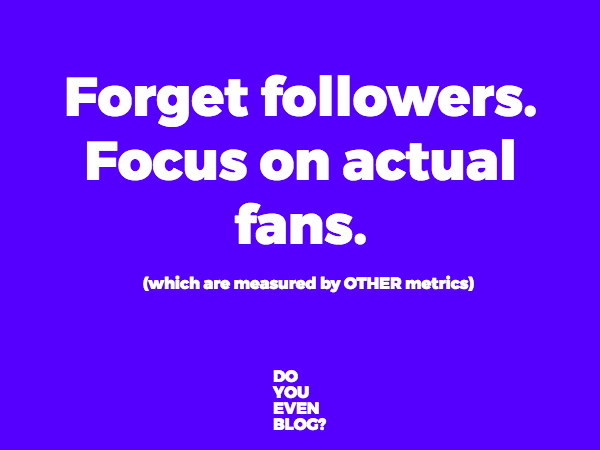
Like your total email list size, your other follower counts only matter so much as you’re actually getting click-throughs!
How many of your followers are actually fans of your content?
Pages per session
Every other digital marketing metrics guide on the internet probably lists this as something you should care about…
But why?
What problem does this metric solve? How does this help you?
Honestly I don’t think it’s that useful.
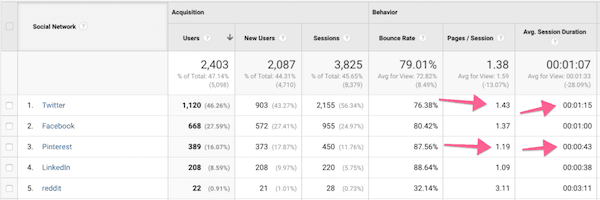
You can view this by traffic source, but what does that even tell you? Which social channels or sources are performing best?
A little, but there are other better metrics for that, which we’ve already covered lol.
Here’s a handy (and FREE) “Check your Blog Stats” Planner and Checklist PDF printable!
The following is designed to help you nail down WHICH metrics to focus on, and let you PLAN your time in Google Analytics, etc so as to MAXIMIZE your ROI!
Let’s find out what works, and do more of that.
Did you enjoy this post?
P.S. If you want to steal the infographic for this page (at the top), use this whereever you can add HTML: <a href="https://doyouevenblog.com/blog-metrics"><img class="size-full wp-image-1781" src="https://doyouevenblog.com/wp-content/uploads/2018/03/Blog-Metric-Infographic-2.png" alt="Do You Even Blog Metric Infographic" width="800" height="2000" /></a>

